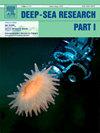Deep water overflow through the southern gap of the Oki Spur in the Japan Sea
IF 2.1
3区 地球科学
Q2 OCEANOGRAPHY
Deep-Sea Research Part I-Oceanographic Research Papers
Pub Date : 2025-08-23
DOI:10.1016/j.dsr.2025.104578
引用次数: 0
Abstract
Water exchange processes between abyssal basins are a problem of universal interest because they control deep water climate. In this study, structure and variability of deep currents running through the southern gap of the Oki Spur from the Tsushima to Yamato Basins in the southern Japan Sea were investigated using the moored current meters and closely spaced hydrographic observations. Our observations revealed that the deep currents are cold, dense water overflows from the Tsushima Basin. Cold water spilling from the southern gap flows southward on the eastern flank of the spur as cold bottom water. Water mass analyses revealed that cold bottom water mixed with upper warmer water decreased its density during the early movement stages and then increased its density by mixing with lateral saline water. A streamtube model assuming a steady state roughly reproduced the depth, density, and velocity of cold bottom water, suggesting that it was in a near geostrophic balance. A strong southward current event accompanying the cold bottom water was observed from late December 1999 to early February 2000. An ocean reanalysis dataset showed that the event was associated with the Tsushima Current in the upper layer, suggesting that surface current variations promoted abyssal inter-basin water mass exchanges. In addition, current fluctuations of ∼10-day periods prevailed in the overflows, suggesting baroclinic instability.
在日本海,深水从冲绳湾的南部缺口溢出
深海盆地之间的水交换过程是一个普遍关心的问题,因为它们控制着深水气候。本研究利用系泊流计和紧密间隔的水文观测,研究了日本海南部对马湾至大和海盆之间的冲冲南段深流的结构和变化。我们的观测显示,深层洋流是来自对马海盆的寒冷、密集的水溢出。从南部裂口流出的冷水以冷底水的形式向南流到马刺的东侧。水团分析表明,在运动初期,底部冷水与上层暖水混合使其密度降低,然后与侧向咸水混合使其密度增加。假设稳定状态的流管模型大致再现了底部冷水的深度、密度和流速,表明它处于接近地转平衡的状态。在1999年12月下旬至2000年2月初,观测到一股强烈的南下洋流伴随底部冷水。海洋再分析数据表明,该事件与上层对马流有关,表明表层流的变化促进了深海盆间水团交换。此外,溢流的当前波动周期为~ 10天,表明斜压不稳定。
本文章由计算机程序翻译,如有差异,请以英文原文为准。
求助全文
约1分钟内获得全文
求助全文
来源期刊
CiteScore
4.60
自引率
4.20%
发文量
144
审稿时长
18.3 weeks
期刊介绍:
Deep-Sea Research Part I: Oceanographic Research Papers is devoted to the publication of the results of original scientific research, including theoretical work of evident oceanographic applicability; and the solution of instrumental or methodological problems with evidence of successful use. The journal is distinguished by its interdisciplinary nature and its breadth, covering the geological, physical, chemical and biological aspects of the ocean and its boundaries with the sea floor and the atmosphere. In addition to regular "Research Papers" and "Instruments and Methods" papers, briefer communications may be published as "Notes". Supplemental matter, such as extensive data tables or graphs and multimedia content, may be published as electronic appendices.

 求助内容:
求助内容: 应助结果提醒方式:
应助结果提醒方式:


